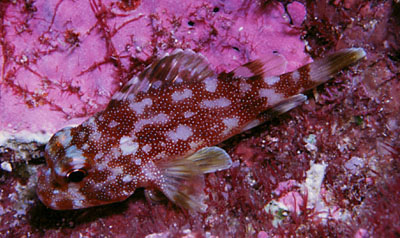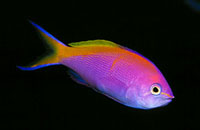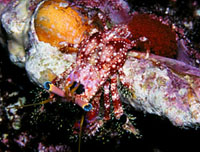|
|
|
(story continued from page 3)
 |
|
Spotted scorpionfish
(c) Mary Jane Adams
|
"There is absolutely no way we could have fulfilled these scientific ambitions without the help of the divers," said Greg while compiling the results en route back to Fiji.
"Not just for their generous funding, diving skill and extra effort underwater, but for the amazing amount of marine life knowledge and intelligent observation they brought to the party."
"This was a tremendously successful collaboration, educational for the scientists too!"
Each diver had a specific job and with it a deep sense of purpose. Representing one of the expedition's sponsors, the World Wide Fund for Nature (WWF), marine biologist, Sangeeta Mangubhai, braved the pounding surf to get ashore on several islands and hike the perimeters counting turtle nests. While Mary Jane Adams kept a meticulous list of small reef fish and built an equally impressive library of matching photos, Bruce Thayer used his video skills to complete the invaluable documentation of reef transects at every site. Craig Cook tried valiantly to estimate numbers in the massive hordes of herbivores grazing the reefs. Sometimes the schools were so tight and thick and moving so quickly and frantically they looked more like carpets unfurling and flying over the slopes and between the bommies. Rob captured all this underwater action on digital video and drew the dive site maps. Australian cameraman and sound technician, Alex Morrison, pitched and tossed about topside filming shipboard and shore side activities and interviewing the characters. Everyone believed that they had the best job. But, in truth, I did. My role was to swim as far as I could to count and identify the big blue-water predatory fish such as snapper, tuna, trevally, rays and sharks.
|
|
|
Trevally schools constantly surrounded us of the reefs slopes
(c) Cat Holloway, NAI'A
|
|
|
Sangeeta Mangubhai - Conservation Management, WWF
It's incredibly thrilling diving as we have no idea what to expect from the currents or the creatures. We feel like modern day explorers! Each moment is busy - underwater we collect samples, record data, count species and shoot video and pictures. Back on deck divers are eager to be first to recount their experience. Between dives we swap discoveries, enter information from our slates into the databases and pour over books attempting to identify our finds. There is so much to learn, we're only scratching the surface.
Inside the lagoon we found a field of thousands of colorful giant clams. As we snorkeled into the shallows, sharks started darting towards us - mainly black tips three or four at a time. But, as we lifted our heads and looked inshore we saw the most astonishing gathering of a hundred or more small reef sharks swarming in just a couple of feet of water! Seven turtles and two mantas later we finally hung up our fins for the day.
|
|
|
|
So what of all that risk? Sound like too much fun to be dangerous? Hardly a breathtaking rush of fear akin to skydiving! True, this was no sudden adrenaline high lasting a few fleeting seconds. But, as 23 days of delicious continuous-release stimulant, it was just as intense.
Sure, there were plenty of those "Oh no, what have I done?" moments. Mighty currents ripped us to windward. Threatening sharks warned us out of the water. A cornered surgeonfish delivered a nasty thigh laceration. Small concerns were exaggerated enormously by the sheer distance we traveled away from civilization and from, well, anything at all.
|
 |
|
Hot Pink Anthias
(c) Mary Jane Adams
|
 |
|
Hermit Crab with her egg mass
(c) Mary Jane Adams
|
|
| But better, this experience was a gift of enduring thrills: memory flashes a year later as we recount our favorite wild encounters or review our images; a stirring sense of unique achievement with tangible rewards of public and private knowledge. This is the rare kind of thrill you can share with others, be they scientists, sport divers, old friends or new neighbors. Because, everyone - old or young, rich or poor, divers or mountain climbers - everyone knows that urge to explore. |
David Obura presented preliminary results of the Phoenix Rising Expedition at the 2000 Coral Reef Symposium in Bali. Greg Stone and Austen Yoshinaga (NEAq), David Obura (CORDIO and, Sangeeta Mangubhai (WWF) presented a full report of the biological surveys and a conservation management plan to the government of the Republic of Kiribati in April 2001. Several topic-specific scientific papers are awaiting publication. And a video/TV program about the voyage is in production. The New England Aquarium and NAI'A are currently planning a return journey in June/July 2002.
NAI'A's passenger-supported research and discovery voyages are proving popular with divers who seek the thrill of the unknown and share a desire to further scientific understanding and conservation efforts in our oceans. As well as the Phoenix Rising Expeditions to Kiribati, the Fiji-based live-aboard hosts exploratory seasons in Vanuatu and winters among humpback whales in Tonga as part of a long term research project. |
|
|
1 - 2 - 3 - 4 |
|
|